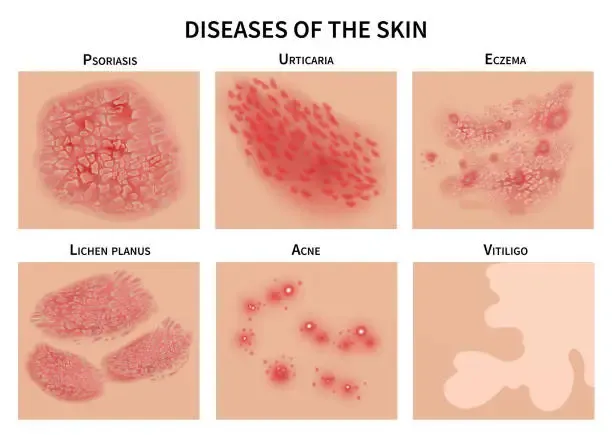A rash is a very broad medical term that refers to abnormal changes in the color or texture of the skin and many more. The rash can be localized in a small area of the body or it can cover a large area.
Symptoms of skin rash
The rash
can appear on any part of the body and may be localized or widespread. If the
rash is widespread, it is often the result of a viral infection or an allergic reaction.
1- The main symptoms of skin rash
The site of
the rash is usually warm and tender and may show the following symptoms:
redness.
Desire to
scratch.
Specific
swelling and characteristic skin lesions.
Chapped
skin.
skin
dryness.
Various
skin lesions on the skin.
The
appearance of crusts on the rash area.
Swelling of
the skin.
Local
burning sensation.
Fluid secretion at the site of the rash.
2- Symptoms of skin rashes indicating the disease
Signs that
may indicate an important medical condition include the following:
Hypersensitivity
to touching the affected area.
Noticeable
swelling.
fever.
Joint pain.
shortness
of breath.
Sore throat
or suffocation sensation.
Red lines
spread from the rash area.
Causes of skin rashes and risk factors for developing them
The rash is
more likely to occur if the patient has a relative suffering from allergies or
asthma. People who spend a lot of time in open areas in nature are more likely
to develop skin rashes as a result of exposure to irritating plants such as nettle
or insect bites.
1- Common causes of skin rashes
Allergic
reactions result from allergies to animals, allergies to various medications, and food allergies.
Bacterial
infections.
Side
effects of various medications.
Excessive
skin abrasion resulting from activities that require effort while wearing
inappropriate clothing.
Fungal
infections.
Parasitic
infections such as scabies.
Insect
bites.
Constant exposure to heat, humidity, diaper rash, and other irritants.
2- Diseases that cause skin rashes.
Diseases
that can cause rashes include the following:
Acne: often
appears on the face, neck, and back.
Lupus
erythematosus: a butterfly-shaped rash on the cheeks and nose.
Lyme
disease: A disease characterized by a circular rash.
Psoriasis:
Psoriasis is a lesion that affects a specific area with well-defined boundaries
covered by scales called plaques.
Complications
of skin rash.
It can cause an untreated rash.
Create a
favorable environment for viral and bacterial infections.
Open sores
are susceptible to infection.
Diagnosis of skin rash
The rash
can be diagnosed by:
Conduct a blood test.
Perform a
biopsy of the rash and analyze it.
Asking
whether the person is allergic to certain medications or foods.
Examine the
shape and appearance of the rash and ask about the symptoms accompanying it.
Treating skin rashes
Treatment of rashes depends on the type of rash and its diagnosis:
The rash
caused by a viral infection is transient, resolves spontaneously within days to
weeks, and does not require medical treatment.
Itching can
be relieved with anti-itch medications or aloe vera ointment.
For rashes
that are worsened by exposure to cold, dry air, moisturizing creams and
sometimes medicated ointments containing steroids can be used.
Skin rashes
caused by infection should be treated with antibiotic ointments, oral
antibiotics, or antifungals.
If the rash
cannot be treated with topical ointments, it may be necessary to use tablets
containing steroids, which can relieve symptoms more effectively.
Preventing skin rashes
To prevent mild rashes, take the following precautions:
Keep hands
and nails clean.
Avoid
contact with irritants.
Use safe
and hypoallergenic products.
Minimize scratching to prevent secondary infection in affected areas.




If you have any questions, please leave a comment